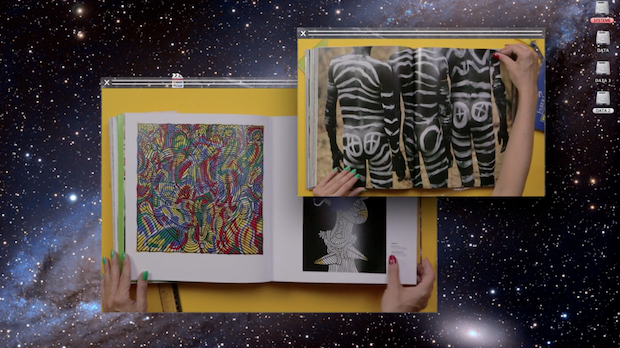Camille Henrot: The Restless Earth
The New Museum, 235 Bowery
May 7th – June 29th
What’s on view: Sculptures made out of flowers, fruit, and other objects; video projections showing situations around the globe; a table with dried flowers atop a Christie’s jewelry catalog; chinese-ink line drawings of humans and animals (sometimes in erotic poses); and the video “Grosse Fatigue,” which won her the silver lion at the 2013 Venice Biennale. (See excerpts on Vimeo)
Whitney: I thought “Grosse Fatigue” is masterful—Henrot pairs image searches with footage from the Smithsonian stock room, and uses the imagery to tell the Biblical Creation Myth, through a spoken-word song by Joakim. For example:
“First there was nothing, and then, an explosion” (footage of marbles rolling around on a table top) and “Who can understand the loneliness of Gods?” (Image of dead birds being pulled out of an antiseptic basement file drawer at the Smithsonian)
As the Creation Myth gets more complex, the overwhelming windows do start to resemble Internet fatigue; we end up with a vortex of images, containing encyclopedic classifications of caged animals, or Wiki’s world map of bipolar disorder and schizophrenia. It turns the Internet into an oppressive colonialist force that tries to curate the whole world. Echoed, for better or worse, by Venice Biennale/New Museum curator Massimiliano Gioni’s boundless encyclopedic ambitions.
“Grosse Fatigue” does a great job of re-contextualizing found images; not so much with the rest of the pairings, like flowers matched with quotes by famous philosophers and writers. It’s along the same lines as colonialist oppression, but it’s feels more like it’s just an art project.
Paddy: Do we know these are all found images? Some of them look very specific to the Smithsonian and likely hard to get. I like all the kinds of systems showcased in this video. There’s a shot of lockers, file cabinets, browser windows, google searches. Jackson Pollock gets a jab when his image is overlaid with the words “In the beginning there was no shape or life”. Gestural and intuitive art making is not of interest to Henrot! Even one of the early images in the film—a woman rolling an orange—has a color test next to it; creation and calibration are the one and the same—or at the very least mixed. By the time we get to the end of the creation myth, the final words aren’t too much of a surprise. “God blessed the seventh day. The earth was heavy. Relaxation is the system”
So Henrot likes systems. As subject matter, they tend to hold particular interest to artists who also code, so it’s not surprising to see people link them to whatever Internet artmaking label out there. That said, there’s also a lot of easy pitfalls for artists working in this field, and I think we see a lot of them in the rest of the show. Sometimes it’s hard to know what’s being said; Does the text informing me that the canine diversity website collected mostly images of dogs in the early aughts tell me anything more because it’s paired with a horsetail fern? I don’t get it. The flowers taken from various pots on the upper east side and pressed in the Christie’s catalogue of Princess Salimah Aga Khan’s jewels seemed a particular low point. All we’re looking at here are stereotypes associated with wealth in femininity. It would have been nice if Henrot had anything to say about these subjects.
Corinna: This exhibition, like many of the others currently on view at the New Museum, require a lot of time. That’s not a bad thing at all, just plan on spending an hour here if you want to watch all the videos.
Henrot has a patchwork sensibility, and that comes most clearly in the first room, filled with odd, somewhat mysterious plant-fruit-object sculptures. Each arrangement started with a quotation, like “a tranquil exile out of the enemy’s reach” from Volodine’s Post-Exoticism in Ten Lessons: Lesson Eleven. For that quotation, there was a single flower with its stem poked into the top of a pineapple.
I kinda get that the flower is maybe striving to be free from the exotic pineapple (or something), but it’s not exactly clear where she’s going with these works. Still, it’s hard to hate on flowers too much.
But the main thing I wanted to talk about was how after seeing The Restless Earth, all I could think about was how Camille Henrot keeps getting lumped into the “post-internet” category. After seeing this show, I just don’t think she’s a post-internet artist—which Marisa Olson defined in 2006 as art that is the yield of surfing and downloading. Other than “Grosse Fatigue,” it seems her interests mainly lie with animal-human relations (all of her ink drawings) and the problems of partial histories (her video “Coupé/Décalé”) .
In “Grosse Fatigue,” there’s a girl with seapunk fingernails holding an eyeball, a frog sitting atop an iPhone, and all sorts of other images derived from the Smithsonian’s holdings where she held a residency. It’s just window after window of information, popping up on a Mac background. It’s overwhelming, it’s beautiful. But it’s really more about the perennial problems of collecting, and being stuck in a funk over what to include or not. I get that this is a feeling some people have about being online—there’s too much information—but regardless, we still make decisions about what we collect. This isn’t necessarily a new problem, or a post-internet one. Anyway, that category doesn’t have much to do with Henrot’s work; thankfully, she’s got more to offer than being a post-internet oneliner.




Comments on this entry are closed.